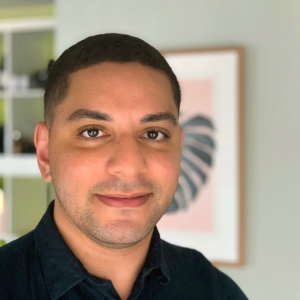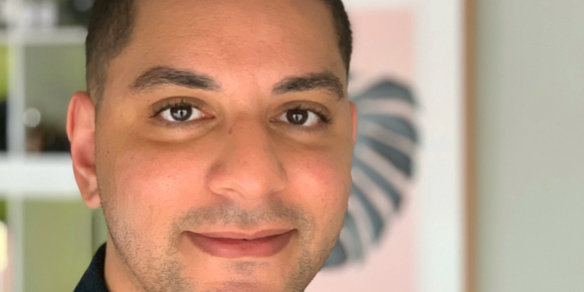Urban Art Project (UAP)
One-on-one with Alan Burden
PhD student working at UAP

Not long ago industrial robots were the focus of science fiction. Today, they are found on every manufacturing factory floor around the world. Believing that industrial robotics is the next frontier for many industries, Alan Burden joined UAP’s Design Robotics team.
Q. What is your background, and what led you to take up a PhD position for this project?
A. I suppose like many people, I have a fairly diverse pathway to my PhD. After school, I first studied Bachelor of Science at University of Queensland (UQ) and majored in anatomy, physiology and psychology. After graduation, I worked in medical pathology as a histology scientist and I enjoyed the work early on but found myself craving to be involved in something creative but still technical.
I enrolled in a Bachelor of Design focusing on architectural studies. I worked in architectural firms during undergraduate years and the master’s program that followed. It was in these final two years that digital fabrication was gaining in popularity and I found most of my projects and interests focused on fabrication techniques and construction prefabrication.
After graduating I worked in architecture, then into research focusing on building modelling and analysis. Later I was offered a role as a designer creating digital content, and project management of audio-visual installations.
I applied for the PhD position as part of the QUT Design Robotics project because many of the industry fields that I worked in over the last 20 years have skillsets that seemingly overlapped with the areas of research within this project. The project interested me because I enjoyed using digital tools and had experience within the design industry since playing with CNC-controlled machines in my undergraduate years. I imagined that industrial robotics was the next frontier for many industries, and as a naturally curious person, I wanted to be part of these future industries.
Q. Tell us a bit about the Design Robotics project, and your role within the project?
A. The Design Robotics project is a collaboration between our industry partner Urban Arts Projects (UAP), two universities – QUT and RMIT, and the IMCRC. UAP is a unique company that produces art predominately for the public realm – ranging from human scales up to building-sized installations. QUT’s involvement with UAP is a five-year project incorporating industrial robotics, robotic vision systems, and software user-interfaces to increase the commercial competitiveness of Small-Medium Enterprises (SMEs) such as UAP.
QUT’s contribution to the project focusses on using industrial robots and supporting technologies to polish foundry-cast artwork. The many stages of polishing the foundry pieces usually consist of many hours of intensive skilled human labour. The goal of this project is to assist human operators by reducing the time and cost of this process and enhance UAP’s ability to manufacture high-value products.
As one of the QUT PhD students, my role within the team is multifaceted. My time is divided between designing end-effectors (i.e. the tools at the end of the robot arm), programming robot actions and toolpaths, and collaborating with our mechatronics engineers and designers to complete smaller tasks. Good observations and documenting research outcomes for publications is also important. Each of these smaller goals incrementally adds to completion of our larger milestones and gathers towards our final goal of efficient robotic polishing of UAP’s bespoke, uniquely formed artworks.
Q: What do you like most about the research?
A: I enjoy the diverse challenges within this project – like multiple pieces of a puzzle leading to a larger solution. Every positive outcome is preceded by a variety of ‘less-successful’ experimentations, and this process is sometimes originated from quite innovative ideas and surprising solutions.
There is also the excitement of this research being exploratory – as a relatively uncharted area of investigation that needs an element of curiosity, individual thinking but also practical application and teamwork for happy, successful outcomes.
Being part of a research team informs my own PhD research looking at how robots can be used collaboratively within the context of UAP’s environment. Being part of such a dynamic environment is a positive experience as preconceived ideas, concepts and limitations can often be rapidly altered. This forces us to be agile and adaptive in our approaches.
Q: How do you feel about an industry-led research project?
A: It’s a great idea. I have worked in both commercial companies in a variety of industries and also within a university – I believe that industry-led projects are an excellent way of creating robust, applicable research knowledge and practical commercially viable outcomes. Having a myriad of stakeholders is a great driver to be accountable for research output but also to stay focused on relevant problems and opportunities in a real-world context.
Q: What do you see yourself doing after completing the PhD?
A: After my PhD, I would like to return to commercial industry. I pursued my PhD because I knew it would expose me to new technologies, ideas, and ultimately provide me with a set of skills and experiences that would be applicable for the future. It is difficult to say what the industrial landscape will look like in 2 years because of the perceptible changes we are currently witnessing from an influx of robotics research and artificial intelligence applications. I think current industry roles will change, and new jobs and specialities will be created around robotics in most Australian and global industries. When opportunities for the application of new technologies and novel solutions to industry occurs, I want to be part of the new adaptive SMEs, global companies, or innovative consultancies within this new world environment.
